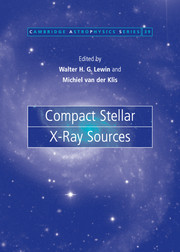Book contents
- Frontmatter
- Contents
- List of contributors
- Preface
- 1 Accreting neutron stars and black holes: a decade of discoveries
- 2 Rapid X-ray variability
- 3 New views of thermonuclear bursts
- 4 Black hole binaries
- 5 Optical, ultraviolet and infrared observations of X-ray binaries
- 6 Fast X-ray transients and X-ray flashes
- 7 Isolated neutron stars
- 8 Globular cluster X-ray sources
- 9 Jets from X-ray binaries
- 10 X-rays from cataclysmic variables
- 11 Super-soft sources
- 12 Compact steller X-ray sources in normal galaxies
- 13 Accretion in compact binaries
- 14 Soft gamma repeaters and anomalous X-ray pulsars: magnetar candidates
- 15 Cosmic gamma-ray bursts, their afterglows, and their host galaxies
- 16 Formation and evolution of compact stellar X-ray sources
- Author index
- Subject index
16 - Formation and evolution of compact stellar X-ray sources
Published online by Cambridge University Press: 01 September 2009
- Frontmatter
- Contents
- List of contributors
- Preface
- 1 Accreting neutron stars and black holes: a decade of discoveries
- 2 Rapid X-ray variability
- 3 New views of thermonuclear bursts
- 4 Black hole binaries
- 5 Optical, ultraviolet and infrared observations of X-ray binaries
- 6 Fast X-ray transients and X-ray flashes
- 7 Isolated neutron stars
- 8 Globular cluster X-ray sources
- 9 Jets from X-ray binaries
- 10 X-rays from cataclysmic variables
- 11 Super-soft sources
- 12 Compact steller X-ray sources in normal galaxies
- 13 Accretion in compact binaries
- 14 Soft gamma repeaters and anomalous X-ray pulsars: magnetar candidates
- 15 Cosmic gamma-ray bursts, their afterglows, and their host galaxies
- 16 Formation and evolution of compact stellar X-ray sources
- Author index
- Subject index
Summary
Introduction and brief historical review
In this chapter we present an overview of the formation and evolution of compact stellar X-ray sources. For earlier reviews on the subject we refer to Bhattacharya & van den Heuvel (1991), van den Heuvel (1994) and Verbunt & van den Heuvel (1995). The observations and populations of high-mass X-ray binaries (HMXBs) and low-mass X-ray binaries (LMXBs) were covered earlier in Chapter 1 by Psaltis.
In our Galaxy there are about 100 bright X-ray sources with fluxes well above 10−10 erg cm−2 s−1 in the energy range 1–10 keV (above the Earth's atmosphere). The distribution of these sources shows a clear concentration towards the Galactic center and also towards the Galactic plane, indicating that the majority do indeed belong to our Galaxy. Furthermore, a dozen strong sources are found in Galactic globular clusters (Section 8.2) and in the Magellanic Clouds. Shortly after the discovery of the first source (Sco X-1, Giacconi et al. 1962) Zel'Dovitch and Guseinov (1966), Novikov and Zel'Dovitch (1966) and Shklovskii (1967) suggested that the strong Galactic X-ray sources are accreting neutron stars or black holes in binary systems. (The process of mass accretion onto a supermassive black hole had already been suggested as the energy source for quasars and active galactic nuclei by Salpeter (1964), Zel'Dovitch (1964) and Zel'Dovitch and Novikov (1964).)
The X-ray fluxes measured correspond to typical source luminosities of 1034 – 1038 erg s−1 (which is more than 25 000 times the total energy output of our Sun).
- Type
- Chapter
- Information
- Compact Stellar X-ray Sources , pp. 623 - 666Publisher: Cambridge University PressPrint publication year: 2006
- 270
- Cited by

